
Overview
Compatibility & Temperature
Grade Tolerances
Nutrition Information
Lemons

In the meantime, Arizona had developed lemon orchards, though on a smaller scale than California. In the 1956-57 season, California produced 11 million gallons (42 million liters) of frozen lemon concentrate while Florida's output was still very small. California and Arizona became the leading sources of lemons in the western hemisphere. In recent years, California has produced nearly double the crop that can be profitably marketed fresh or processed. Foreign competition has increased and many California growers have destroyed their lemon groves or top worked the trees to oranges, but new cultural techniques making summer production possible may reverse the trend.
Sources: The Produce Blue Book
Origin and Distribution
The true home of the lemon is unknown, though some have linked it to northwestern India. It is supposed to have been introduced into southern Italy in 200 A.D. and to have been cultivated in Iraq and Egypt by 700 A.D. It reached Sicily before 1000 and China between 760 and 1297 A.D. Arabs distributed it widely in the Mediterranean region between 1000 and 1150 A.D. It was prized for its medicinal virtues in the palace of the Sultan of Egypt and Syria in the period 1174-1193 A.D. Christopher Columbus carried lemon seeds to Hispaniola in 1493. The Spaniards may have included lemons among the fruits they introduced to St. Augustine. They were grown in California in the years 1751-1768. Lemons were reported to be increasingly planted in northeastern Florida in 1839. Because of heavy imports from Sicily, commercial culture in Florida and California was begun soon after 1870 and grew to the point where 140,000 boxes were being shipped out of Florida alone. The small Florida industry was set back by a freeze in 1886, the susceptibility of the lemon to scab, and the unfavorable climate for curing the fruit, and also competition from California. Following the devastating freeze of 1894-95, commercial lemon culture was abandoned in Florida. Not until 1953 was interest in lemon-growing revived in Central Florida to take advantage of the demand for frozen concentrate and for natural cold-press lemon oil. At that time, Florida was importing lemons from Italy for processing. Plantings grew to 8,700 acres by 1975. Freezes caused 50% reduction by 1980. Still, in 1984, Florida exported $2 million worth of lemons.

Storage
Florida's climate is unfavorable for long-term curing. It has been claimed that a 10-day curing period is adequate and de-greening of Florida fruit is not needed. A major producer keeps the newly harvested fruits for 48 hours at 60º F (15.56º C) and 95% humidity, then passes them through a pre-grading procedure to eliminate all that are unusable. The usable fruits are then treated with fungicide against stem-end rot and returned to the curing room. Those harvested early in the season need 3 weeks to color-up, the last may require less than a week. Finally, the fruits are washed, given a second fungicidal treatment, dried, waxed and packed.
Generally, lemons are cured at 56º to 58º F (13.33º-14.4º C)and 85-90% relative humidity. Green fruits may be held for 4 months or more, while the peel becomes yellow and thinner, the pulp juicier (6-80%) and the proportion of soluble solids higher (7-24%). Sometimes the degreening process is hastened by exposing the fruit to ethylene gas, ethephon, or silane, but this practice tends to stimulate decay, mainly through the shedding of the "button" (stem stub), the absence of which allows entry of Diplodia natalensis, Phomopsis citri, or Alternaria mycelium. Various auxins have been studied to determine which can be applied before storage to prevent button loss without delaying de-greening. In 1982, Israeli investigators reported that decay losses from de-greening procedures can be greatly reduced (from over 50% to 6.3%) by packaging the fruits in 10 micrometer-thick high-density polyethylene. This treatment makes it possible to store lemons with minimum damage for as long as 6 months.
Sources: The Produce Blue Book

Summary of Published Grade Standard Tolerances
In order to allow for variations incident to proper grading and handling in each of the foregoing grades, the following tolerances, by count, based on a minimum 25 count sample, are provided as specified:
(a) U.S. No. 1 grade --
For defects at shipping point. Not more than 10 percent, by count, of the lemons in any lot may fail to meet the requirements relating to color. In addition, not more than 10 percent, by count, of the lemons in any lot may fail to meet the remaining requirements of the grade, included in this amount not more than 5 percent shall be allowed for defects causing serious damage, included in this latter amount not more than 1 percent for decay.
For defects en route or at destination. Not more than 10 percent, by count, of the lemons in any lot may fail to meet the requirements relating to color. In addition, not more than 12 percent, by count, of the lemons in any lot may fail to meet the remaining requirements of the grade: Provided, that included in this amount not more than the following percentages shall be allowed for defects listed: 10 percent for fruit having permanent defects; or 7 percent for defects causing serious damage, including therein not more than 5 percent for serious damage by permanent defects and not more than 3 percent for decay.
Nutrition Facts
Serving Size 1 fruit without seeds
Amount Per Serving
Calories from Fat 3Calories 22
% Daily Values*
Total Fat 0.32g 0%
Saturated Fat 0.042g 0%
Polyunsaturated Fat 0.096g
Monounsaturated Fat 0.012g
Cholesterol 0mg 0%
Sodium 3mg 0%
Potassium 157mg
Total Carbohydrate 11.56g 4%
Dietary Fiber 5.1g 20%
Sugars -
Protein 1.3g
Vitamin A 1% Vitamin C 139%
Calcium 7% Iron 4%
* Percent Daily Values are based on a 2000 calorie diet. Your daily values may be higher or lower depending on your calorie needs.
Nutrition Values are based on USDA Nutrient Database SR18

Century Farms International, Inc.
10957 NW 123rd Street Medley, FL 33178
Office: 305-436-7971 Fax: 305-436-7968



